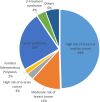Prevalence of Constitutional Pathogenic Variant in a Cohort of 348 Patients With Multiple Primary Cancer Addressed in Oncogenetic Consultation
- PMID: 40022545
- PMCID: PMC11871423
- DOI: 10.1002/mgg3.70086
Prevalence of Constitutional Pathogenic Variant in a Cohort of 348 Patients With Multiple Primary Cancer Addressed in Oncogenetic Consultation
Abstract
Introduction: Multiple primary malignancies (MPMs) refer to two or more primary malignant tumors in the same patient. MPMs are frequent: 18.4% of incident cancers represent a second or a higher primary cancer. In order to assess the value of genetic testing for patients with multiple cancers, studies are needed to accurately determine the prevalence of pathogenic variants for these patients.
Methods: All families were seen in our oncogenetics consultation from 2010 to 2022. We compared clinical features and detection rates of pathogenic or likely pathogenic variants in a panel of up to 47 cancer predisposition genes in patients with ≥ 2 primary cancers (n = 348) versus a single primary cancer (n = 1422).
Results: A pathogenic or likely pathogenic variant was diagnosed in 27.3% of patients with 348 index patients with MPM, concerning 21 genes: BRCA1 (n = 27), BRCA2 (n = 19), MSH2 (n = 9), ATM (n = 8), MLH1 (n = 5), MSH6 (n = 6), TP53 (n = 4), CHEK2 (n = 4), PALB2 (n = 3), APC (n = 2), MEN1 (n = 1), RAD51C (n = 1), NBN (n = 1), EPCAM (n = 1), PMS2 (n = 1), RB1 (n = 1), PTEN (n = 1), CYLD1 (n = 1), NF1 (n = 1), RAD51D (n = 1), and CDKN2A (n = 1). MPM index cases were more likely to carry a deleterious mutation than cases with a single cancer (27.3% vs. 11.39%, p < 0.001). Pathogenic variants were found more frequently in patients with a suggestive family history (34.2% vs. 20.1%, p < 0.05), with a younger age of cancer diagnosis related to the suspected syndrome (32.7% vs. 22%, p = 0.049). For the 208 index patients with ≥ 2 cancers pertaining to the same predisposition syndrome (HBOC, HNPCC…), the detection rate increased significantly to 36% (vs. 14.3% for MPM patients with unrelated cancers (n = 140), p < 0.001). Conversely, the detection rate for patients with unrelated cancers was not statistically different from the single-cancer population (14.3%-11.39%, p = 0.318).
Conclusion: Patients referred for oncogenetic testing with MPM are more likely to carry pathogenic variants in cancer predisposition genes than patients with a single primary cancer (p < 0.05), especially if the cancers are related to the same predisposition syndrome. If the cancers are unrelated, no statistical difference in comparison to the single-cancer population was observed. For these latter patients, we recommend using the specific criteria of each tumor to propose appropriate genetic testing.
Keywords: genetic testing; germline; multiple primary cancer.
© 2025 The Author(s). Molecular Genetics & Genomic Medicine published by Wiley Periodicals LLC.
Conflict of interest statement
The authors declare no conflicts of interest.
Figures



References
-
- Adamo, M. , Dickie L., and Ruhl J.. 2018. SEER Program Coding and Staging Manual 2018. Department of Health and Human Services National Institutes of Health National Cancer Institute.
-
- America Cancer Society . 2019. “Cancer Treatment & Survivorship Facts & Figures 2019‐2021.” cancer‐treatment‐and‐survivorship‐facts‐and‐figures‐2019‐2021.pdf.
-
- Billroth, T. 1889. Die Allgemeine Chirurgische Pathologie and Therapie. 51 Vorlesungen. Ein Handbuch fur Studierende and Artze. G Reimer.
MeSH terms
LinkOut - more resources
Full Text Sources
Research Materials
Miscellaneous

